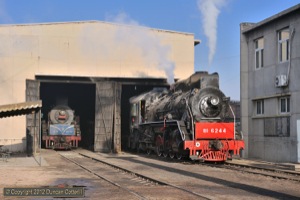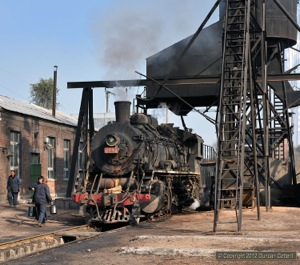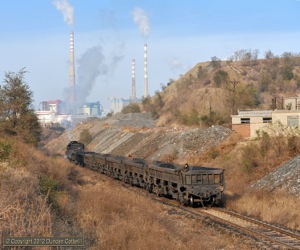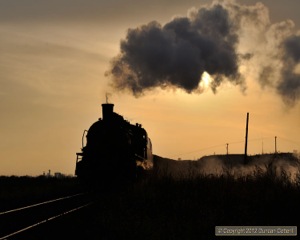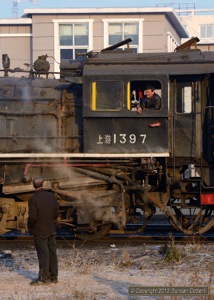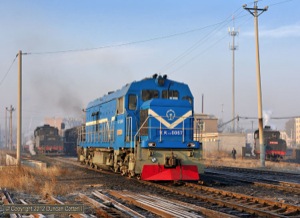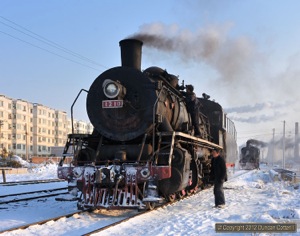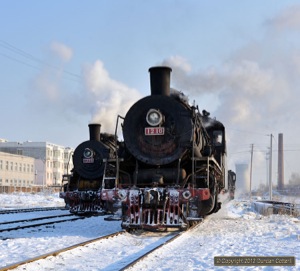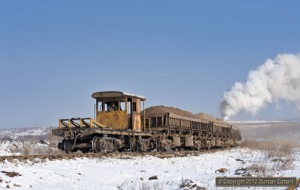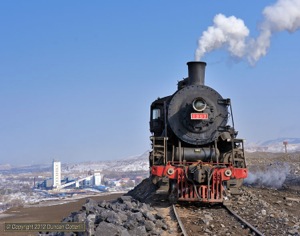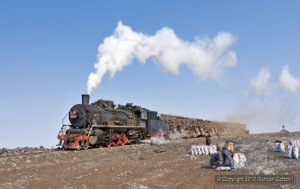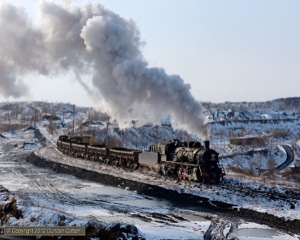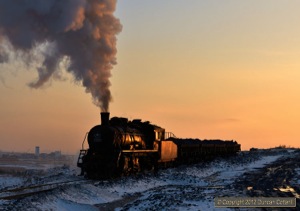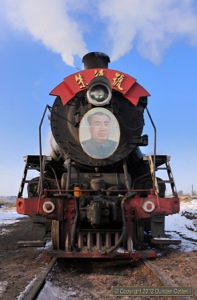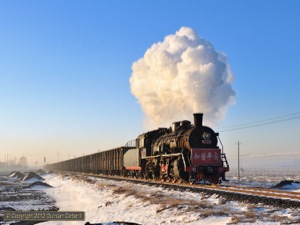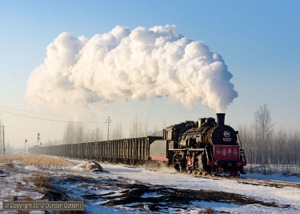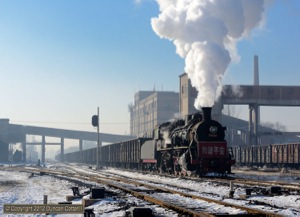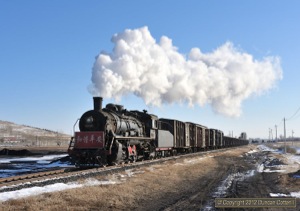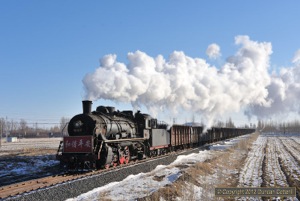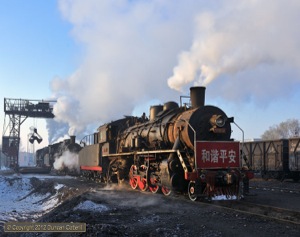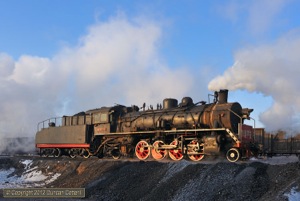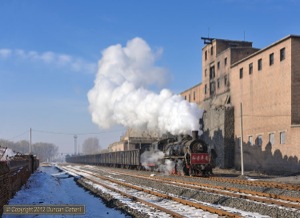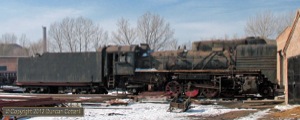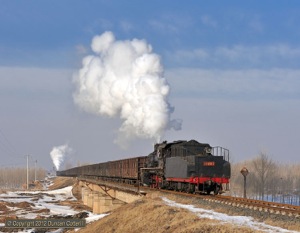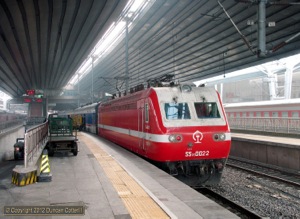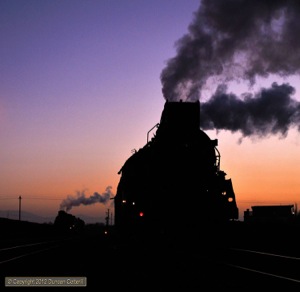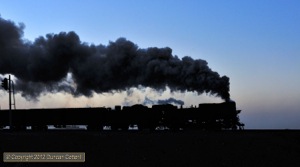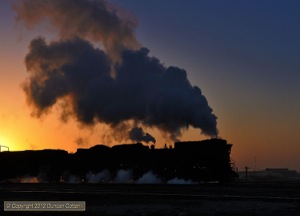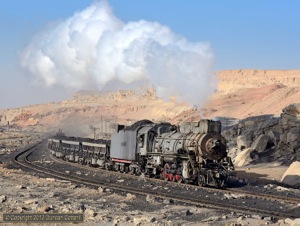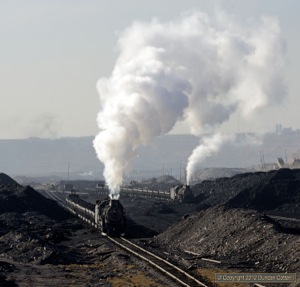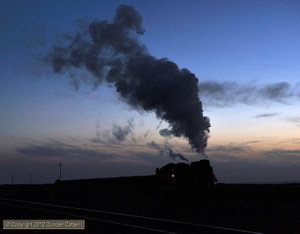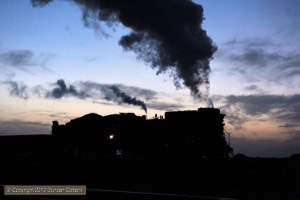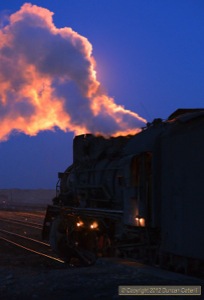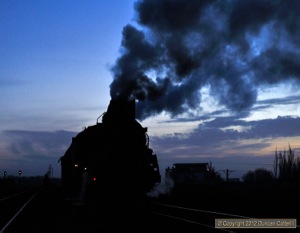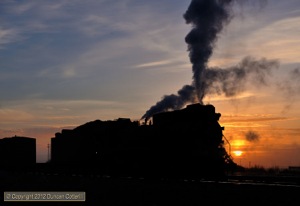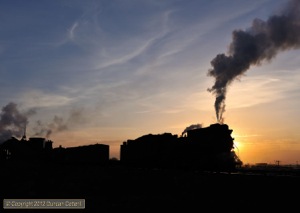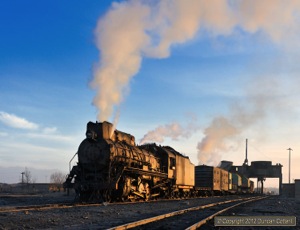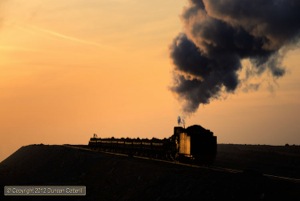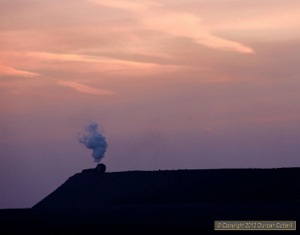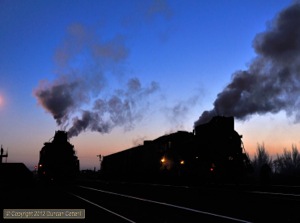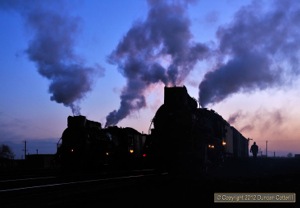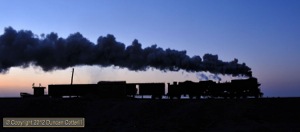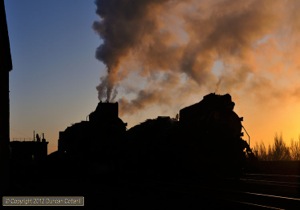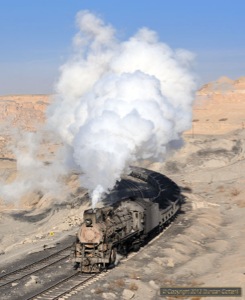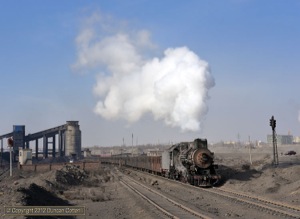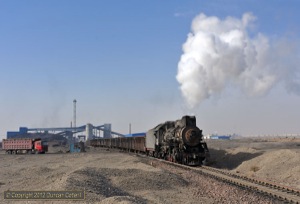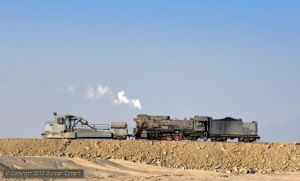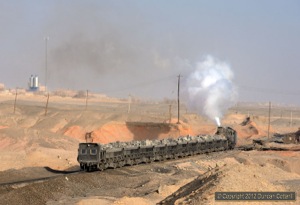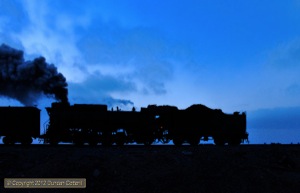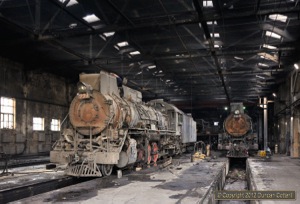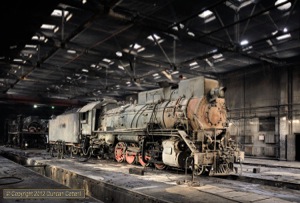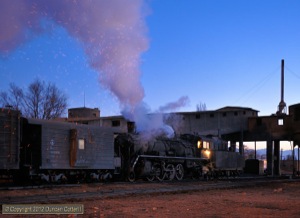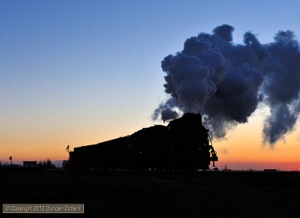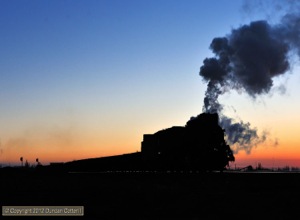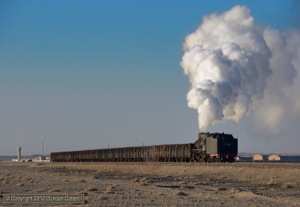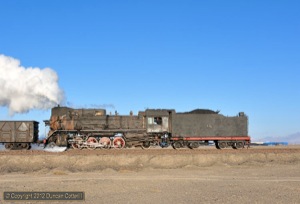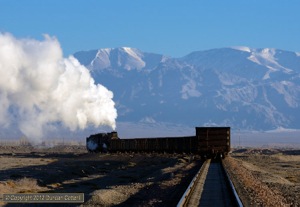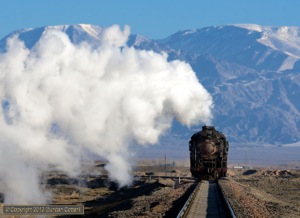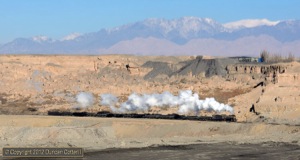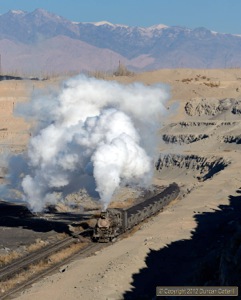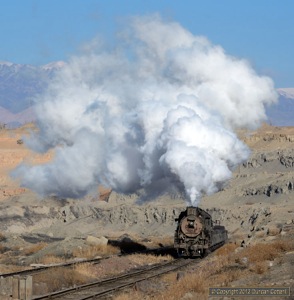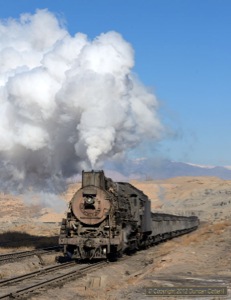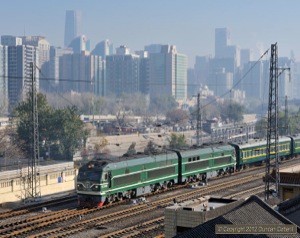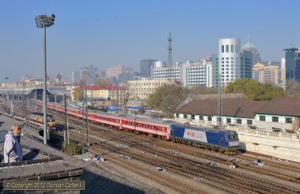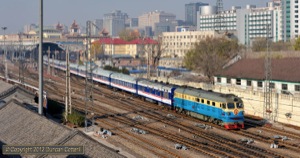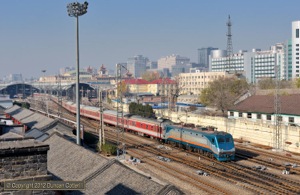Last Chance for Steam?
07 - 25 November 2012
Report by Duncan Cotterill
Introduction
The last few years have seen many of the best Chinese steam locations dieselise, electrify or abandon their rail systems altogether. Just enough survived to justify one last trip in November 2012. There were just the three of us this time, Peter Breeze, Sun Xiaolan and myself, and we visited Bajiaotai, Fuxin, Pingzhuang and Sandaoling. This report covers what we found at those locations. We did all the long journeys by rail this time so there are extensive observations of the current Chinese rail scene as well.
UK to Jinzhou
(Wed 7 – Thu 8 November 2012)British Airways fares compared well with the acceptable alternatives so we took direct flights from the UK to China this time. The journey from Heathrow to Beijing was uneventful and we landed around 10 minutes early. The queues at immigration were a bit slow but that meant we didn’t have to wait long for the baggage to arrive. A little over half an hour after our scheduled arrival time, we had met up with Xiaolan and were ready to travel into Beijing, a long slow bus ride that took us to a stop within a few yards of the main station but still in plenty of time for our booked departure at 14:30.
Train D73, the 14:30 from Beijing to Jilin, was formed of CRH5 sets 058 and 019, built at Changchun using Alstom technology. Departure was spot on time and we arrived at Jinzhou Nan on schedule at 18:00.
Nothing particularly exotic was seen around Beijing station. DF4.1758 and DF7.3020 were on station pilot duties. HXD3.0495 was waiting to leave with T177 to Wulumuqi and HXD3.0488 arrived with K616 from Datong as we left. There were plenty of SS9G on shed but none were actually seen on trains during the journey, so perhaps they don’t work to Shenyang as regularly as they once did. A few SS9 were also present as well as several HXD3, HXD3C, DF11, DF11G and a DF10F twin unit. The only really old loco noted at the depot was an NY5/6/7 that was clearly out of use.
The first real surprise was seeing two of the original chopped nose DF7s shunting the freight yard at Beijing Dong. I’d assumed they had been replaced by more modern locos years ago.
Freights on the direct line from Beijing to Shanhaiguan via Tangshan Bei were hauled by HXD2B or SS4B electrics with a few DF8Bs also seen. No SS1s were noted anywhere en-route. Passengers were worked by a mixture of HXD3C electrics and DF4D and DF11 diesels, including a westbound with one of the green DF11Z twin units on the front. At Shanhaiguan a number of HXD3B were seen on freight, presumably employed on the line east towards Shenyang. Our train took the LGV eastwards so no more observations were made.
Major line changes appeared to be underway between Beidaihe and Qinhangdao, including a complete rebuild of Qinhuangdao station. Presumably the intention is to eliminate conflicting moves between passenger and freight trains in this busy area.
At Jinzhou Nan we were met by our driver and travelled into town to find our hotel for the first night.
Jinzhou Power Station, Bajiaotai
(Fri 09 November 2012)A morning visit found JS.6211 and JS.6244 in steam. JS.8116 was spare cold. JS.6244 was in splendid condition following an October 2012 overhaul by Sujiatun. As is often reported from this place, there was no sign of any imminent activity. The security guard was keen to move us on, so we left for Fuxin after taking a few pictures. Bajiaotai isn’t worth a visit unless you’re passing, which we were. There’s little chance of activity and few, if any photogenic locations. Nice to see an ex-works JS in late 2012 though, especially one that’s around 30 years old.
Fuxin Mining Railway
(Fri 09 to Tue 13 November 2012)Fuxin’s slow decline continues. Since our last visit in November 2011 the passenger trains have stopped running and the eastern end of the line from Ajin to Xinqiu has been taken out of use. From Chengnan to Ajin there are only two or three trains a day and they generally run at night, according to a crossing keeper on this section. West of Chengnan is busier with some daylight trains to and from the power station there.
A total of 10 locos were seen in steam during our visit (SY.0770, 1210, 1319, 1320, 1359, 1378, 1395, 1396, 1397, 1460). Another three engines were under repair in the works (SY.0988, 1195, 1414) and a fourteenth (SY.0941) was out of service and possibly being stripped to supply spare parts. That covers the 14 steam locos we expected to see at Fuxin. Diesels DF5D.0066, 0067 and 0068 were also seen during our visit. Most days only two of the three diesels were in use but on Sunday 11 November, all three were at Ping’an for the morning shift change.
Decorated SY.1395 (Zhu De Hao)was still based at Taiping and worked independently of the other SYs. It seemed to have a semi-regular duty which involved propelling a rake of wagons north-east from Wulong Yard to Taiping then dragging them south-westwards over the former electric line, through the site of the abandoned washery yard, before propelling them into a siding nearby for loading. Most of the time it could be found sitting at Taiping, waiting for something to do. A visit there on 13 November found that the snow that had fallen two days previously was still on the rails around the loco, indicating it hadn’t been anywhere in that period. The supervisor at Taiping said he expected that operations there would cease in the near future.
The other nine active SYs seemed to be used interchangeably with each other but not with the diesels, which spent most of their time working south-west of Wulong Yard to the CR exchange sidings, Minzhu and Wangying. Steam was used on most workings north-east of Wulong Yard and to Wulong Mine and the adjacent spoil tip. We did see the occasional steam working to the west and the occasional diesel working to Wulong Mine but not to the tip.
A new connection between the former surface and opencast systems close to Ping’an Mine allows direct access from Wulong Mine to the opencast pit and was being used to take spoil from the mine into the pit for dumping at a point just below Taiping. Only one particular grade of spoil appeared to be involved, with the remainder going to the tip above the mine. During a three-hour period on Sunday 11 November, four spoil trains were seen going into the pit, each one returning empty around 30 minutes later. A similar number of trains went to the main spoil tip over the same period, two of them coming from Wulong Mine and two from elsewhere on the system.
A new branch connecting a loading point at the back of Ping’an Mine to the line into the opencast mine has been laid but was awaiting ballasting at the time of our visit.
A number of withdrawn locos were dumped at various locations around the system. We didn’t go out of our way to find them all but saw JF.508, SY.0036, 0076, 0127, 0391, 0576, 0770 dumped in the carriage sidings adjacent to the depot, along with around 13 coaches. The real SY 0770 is still in use and carries the correct 1974/01 plates. The true identity of the dumped one remains a mystery. Derelict SY.0541 and YJ.403 were still rotting away at Taiping and SY.0895 was still stored/dumped in the coal yard adjacent to Chengnan CR station.
Photography
Fuxin still has plenty to offer the photographer with plenty of activity and some interesting urban/industrial locations and, with around eight SYs in use every day, it has more active steam locos than anywhere else except Sandaoling. The gathering of locos at Ping’an every morning didn't seem particularly productive this year. There were plenty of locos there but they rarely seemed to be positioned in good spots for photography. Ping'an is getting more popular with local photographers and the morning after the snow fell it was mobbed by locals, many of them wearing brightly coloured clothing and photographing the locos and crews from very close up. All we could do was stand back and watch. It took a surprisingly long time for mine security to turn up and chuck everyone out. On other mornings, when there were just the three of us around, security seemed much less interested and we were never challenged when photographing at other locations on the system.
The weather was far from perfect during our visit. Our first day was sunny but very hazy and the second started the same way but had clouded up by early afternoon. By the evening it was raining heavily. The rain continued most of the following day, turning to snow by mid afternoon, combined with a strong wind. The fourth day was brilliantly clear and sunny from start to finish but the strong north-westerly wind made photography difficult until the afternoon. Our fifth and final day started clear and much less windy but soon clouded up. We left for Pingzhuang mid-morning.
CR Fuxin Area
DF4D.0244 (alloc=Shenyang) was seen near Xinqiu on 10 November, hauling a long set of coaches towards Fuxin at 16:11. From the destination boards carried, this appeared to be the stock for train 1230/1227, the 16:50 Fuxin – Shanghai. An immaculate DF4.9491, in DF4C style blue and cream livery, was stabled in the new concrete bridge factory sidings at Xinqiu. The factory is served by a new branch from Xinqiu CR station that follows the route of the now defunct connection from the mining railway station to CR.
Fuxin to Pingzhuang
(Tue 13 November 2012)We travelled by road from Fuxin to Pingzhuang, paralleling the new Chifeng – Jinzhou coal line much of the way from Chaoyang to Pingzhuang. The line appeared to be close to completion with all the civil works complete, track laid and ballasted and signals in place. No trains were seen although there was a track inspection vehicle at one station and a few ballast wagons at another. The line is single track throughout with many spectacular viaducts and tunnels. It has to be assumed that the line will be diesel worked as there were no signs of electrification anywhere.
Pingzhuang Mining Railway
(Tue 13 to Thu 15 November 2012)Probably the most significant good news story on the steam front recently was buried deep in John Raby’s blog. Pingzhuang has turned its engines round! Getting chimney first locos actually working used to be difficult as they could coast most of the way in that direction and only worked hard when running tender first. Fortunately, chimney first engines can now be photographed working uphill in a number of reasonable locations. The system is still very quiet compared to places like Fuxin and Sandaoling but the combination of clean engines and long trains makes it quite attractive, especially with a bit of snow on the ground.
Only four engines were seen in use during our two-day stay. SY.1017, SY.1052 and SY.1425 worked on the deep mine system each day, while SY.1764 was seen on the opencast side. No other locos were seen in steam. SY.1025 and JS.1001 were dumped in a compound adjacent to the servicing point with SY.1441 stored in a shed within the compound.
The deep mine system was basically unchanged from previous years with trains running as far as Liujia Mine in the north and Wujia Mine in the south for loading. The washery at Zhuangmei also loaded a significant number of wagons. Trains of empties would be collected from CR at Pingzhuang Nan and taken northwards. Both the trains we saw stopped at Wufeng, where some wagons were left. The rest of the train would then be taken forward to Zhuangmei where some wagons would be left for loading at the washery and others would continue to one or more of the deep mines north of Pingzhuang. Wagons left at Wufeng would later be taken to Wujia Mine, Zhuangmei or the mines north of Pingzhuang as required.
Loaded trains would follow the same pattern in reverse with wagons from the northern collieries being combined with those from the washery at Zhuangmei and those from Wujia at Wufeng before being taken to Pingzhuang Nan.
Trains were infrequent. Our second day saw two trains of empties from Pingzhuang Nan. On the third day, there were none in daylight although wagons brought to Zhuangmei before the morning shift change were taken to Liujia mid-morning. Three loaded trains were seen, one each day, always in mid to late afternoon. On the third day the train stopped at Wufeng where wagons from Wujia were added. The restart from Wufeng was spectacular, with the train banked partway up the grade by the loco that had brought the wagons from Wujia.
The opencast electric operation has closed and coal is now brought out of the pit by large dumper trucks using a new road that takes them directly to the washery. The former washery unloading area and adjacent p-way yard are now enclosed within a walled compound and appear to be disused.
Most of the trackwork on the opencast side is still in place although some sections of overhead wiring have been removed. The double track line leading into the pit was rusty with a snowdrift across the track confirming that nothing had run for a while. No electric locomotives were seen anywhere and the only rail activity was SY.1764 with a crane, recovering track panels from the yard behind the washery.
Photography
With the locos facing north it was like having a new railway to photograph. Every picture was different to anything we had photographed before. The stops for shunting at Wufeng and Zhuangmei also worked in our favour, allowing us to get ahead of trains for a second or even a third shot. Although there wasn’t much activity we still managed to come away with half a dozen really pleasing pictures of trains on the move and many more of the locos being serviced at Zhuangmei in the mornings.
Pingzhuang to Sandaoling
(Thu 15 to Sat 17 November 2012)After a couple of two-day delays at fogbound Wulumuqi airport on previous trips we decided to do the whole journey by train this time. The first leg from Chifeng to Beijing Bei was on train 2560, the overnight express linking the two cities. DF4D.0218 of Tongliao depot provided the motive power. Ironically, thick fog around Huairou Bei delayed our arrival in Beijing, but only by around 20 minutes. That still left plenty of time for us to make the short taxi ride to Beijing Xi to catch the fabled train T69 to Hami.
We had only been able to obtain hard sleeper reservations on T69, the Beijing – Wulumuqi express, but Xiaolan made enquiries while we were waiting and managed to get soft sleeper tickets that had been held back for delegates to the CPCC meeting but hadn’t been required. It was a surprise to find the train hauled from Beijing by Lanzhou depot’s SS7E.0022, a loco I wouldn’t have expected to see so far east. The route would also come as a surprise to anyone who hasn’t kept abreast of the massive expansion of China’s railways over the past decade.
We left Beijing on the upgraded main-line south to Shijiazhuang but then turned west via a newly built high-speed line, much of it in tunnel, to Taiyuan. The next section was over a completely new railway through the middle of nowhere to Zhongwei, on the Yellow River. The last time I travelled from Zhongwei to Beijing it took around 28 hours, via Baotou and Datong, but this time the reverse journey took less than 13 hours. From Zhongwei we continued west via Gantang to Wuwei then followed the traditional main line via Jiayuguan to Hami.
Numerous sightings of interest were made en-route. At Beijing Xi one of the original DF7s was on station pilot duty, as was a more modern DF7G. Locos of classes DF11G, HXD3, HXD3C and SS8 were also seen. South of Beijing HXD2B and SS4B worked most freights and CRH5, SS7E, SS8 and SS9G were noted on passengers. SS1.554 was a very pleasant surprise at Shijiazhuangbei on train 6034 from Taiyuan.
Around Taiyuan a few Russian built class 8G electrics were seen on freights in addition to the more common SS4B twins and the odd SS3B. Original DF7.0147 was shunting a yard in the north of the city. SS1.0281 was seen on a southbound passenger at Taiyuan station at 15:20, probably 4625, 15:30 from Taiyuan to Yongji via Linfen. Orange DF4.2374 was on another southbound passenger that appeared to be a suburban working, with origin and destination stations both in the city, ie Taiyuan-something to Taiyuan-something.
West of Taiyuan the line followed a completely new alignment to Zhongwei, again with many lengthy tunnels. The first stop was town called Lvliang, according to the timetable and station signs. There is no “v” in the Pinyin alphabet, so Lvliang couldn't be right. It appears that the town is actually called Lüliang but the shortcut for “ü” on Chinese keyboards is “v” so the name is a mis-transliteration. Lüliang was one of several towns on the route that appeared to be undergoing a massive expansion with more new buildings under construction than actually in use. East of Lüliang a third SS1 hauled passenger was seen, heading , train 4624, 16:35 from Lüliang to Taiyuan, with SS1.0679.
We’d been a few minutes late all the way from Baoding, south of Beijing, to Suide, west of Lüliang, but by Dingbian, about 3 hours east of Zhongwei, we were back on schedule. No more observations were made until the following morning, except that we were still on time at Jinchang, formerly known as Hexipu.
We should have departed Jiayuguan in darkness the following morning but by now we were 30 minutes late and it was getting light when we left. SS7E.0022 appeared to have been replaced by another Lanzhou based example, SS7E.0044 at some time during the night but from Jiayuguan we had a pair of DF11s on the front. The principal interest at Jiayuguan was to see the great fort that marks the western end of the Great Wall, west of town. It was further from the railway than we'd expected but magnificent nonetheless.
Most passengers seen west of Jiayuguan were diesel hauled, mainly by single or double DF11 but also a few DF4D. A single passenger, 1086, 21:35 Wulumuqi – Jinan (over 3 hours late) was seen leaving Liuyuan for the east behind an SS3B but all other passengers were diesel worked. Freights were solid Lanzhou Bureau SS3B to Liuyuan where Wulumuqi Bureau DF8B took over.
West of Jiayuguan there was much evidence of recent work to upgrade the existing line with relocations in several places and a new high-speed line being built in parallel with the existing route. West of Liuyuan the electrification continued for a while but then we diverged onto the old, unimproved, non-electrified main line for over 100km. It appeared that this part of the route would be replaced by a completely new section of line that looked to be at an advanced stage of construction, with electrification masts and wires already in place. This new section of line was being built in addition to the new high-speed line, where construction wasn’t quite as advanced. Near Yandun, 80km east of Hami, we rejoined the upgraded and electrified route, having lost a further 20 minutes from Jiayuguan. Work was proceeding on both the lines mentioned above, despite reports that it had been suspended due to the economic downturn.
A few km east of Hami we diverged from the original alignment again, running alongside a new and very large freight yard that has been built to the south of the old main line. Most freight traffic west of the new yard was in the hands of Wulumuqi based DF4B. From the yard we followed a new, electrified, freight avoiding line well to the south of the city to a new Hami Nan (South) station in open country, several km from the centre. The new station appeared to be a temporary structure, built to a much lower standard than is usual for new stations in China. My guess would be that the original Hami station is undergoing a complete rebuild and normal services will resume in a year or so. Civil works for the new high-speed line, east and west of Hami, certainly indicate that it will be routed via the city centre and new connecting lines leading from the new yard towards the city centre, as well as recent electrification work on the original main line either side of town, make it highly unlikely that there won’t be conventional railway access as well.
We left train T69 at Hami Nan, met our driver and continued by road to Sandaoling.
Sandaoling Mining Railway
(Sat 17 to Thu 22 November 2012)We found Sandaoling little changed from our previous visit 12 months earlier but noticeably quieter. Whether this was a symptom of lower demand for coal, as has been suggested, or an indication of the rundown of the rail system within the opencast pit, is unclear. As usual, permission was required to visit the Sandaoling mines and was arranged via CITS Hami.
Whereas there had been three or even four locos working coal trains out of the opencast pit last year, this time there were usually only two. For the whole period of our visit, JS.8195 and JS.8225 were the regular locos and were joined occasionally by a third engine, usually one of the spoil fleet (with its 11 wagon train as opposed to the usual 13 wagon sets normally used on coal trains). The regular locos worked chimney first out of the pit but locos on the additional workings could face either way. The coal operation was also very slow to get going in the morning. The coaling facility at Dongbolizhan was out of use, apparently permanently, and coal trains would usually run through the pit to Xibolizhan for coal after shift change and before starting work. It was very unusual to see a coal train leaving the pit before 11:00 and, on occasions, the first train didn’t appear until after 12:00. By 13:30, everything had stopped for lunch and didn’t usually resume until around 15:00. When things did get going, trains could be as frequent as two or even three an hour.
We didn’t spend much time on the spoil operation but it did appear quieter than on previous visits, with several locos and trains usually to be found in the yard at Xibolizhan waiting for work. Taking the line that curves around closest to Xibolizhan as Line 1 and the line that runs well to the east as Line 7, the status was as follows: Line 1 temporarily out of action for track repairs. Line 2 intact but not used recently, Line 3 lifted, Lines 4, 5, 6 and 7 in use. Tipping staff referred to the line to the east as line 5, so what I’ve referred to as line 2 may be out of use permanently. As usual, most locos pushed chimney first onto the tips and pulled tender first off the tips. On one occasion, JS.8089 was seen facing the other way round, and could be photographed hauling trains off the tips chimney first. It was also good to see recently revived JS.6209 at work on spoil trains. JS.6224 on the spreader was the only other 6xxx series loco seen in use. JS.8076, 8078, 8081, 8173, 8368 were also seen on spoil trains.
The passenger train ran as expected from Dongbolizhan to Xibolizhan and back every morning at shift change. Its 08:40 departure time should, however, be considered approximate. It was seen leaving a few minutes early on one occasion and almost 10 minutes late on another. Regular coal train loco JS.8225 worked the train on the first three days with JS.8089 and JS.8190 in use on the following two days. JS.8089 was tender first away from Dongbolizhan but the others were chimney first. There were sometimes one or two crane trains present at Dongbolizhan at shift change time and often one of the coal trains as well. JS.8027, JS.8040 and SY.1304 were all seen on crane trains at various times.
Four different JS were seen working around Nanzhan, JS.8053, 8314, 8358, 8366 but only one DF8B appeared to be in use. The other three were stabled in the yard every time we passed Nanzhan. Recently reported JS.6204 was not seen but the tender of stored SY.1729 could be glimpsed through a factory gate close to Nanzhan. Beiquan Erjing appeared to be the most productive of the deep mines but loaded trains were also seen coming from Yijing on two occasions. As always, it was very difficult to predict when the trains would run to the deep mines, you just had to turn up and see whether there were a lot of empties waiting in Nanzhan yard, then wait to see if they would be taken to the mines. The only train we saw going to the mines was relatively short and hauled by a single loco, no bankers were seen.
Four locos were in the works when we visited on 21 November, JS.6224 for running repairs, JS.8189 appeared to be receiving a medium level overhaul and JS.8080 a heavy overhaul. JS.8077 was awaiting accident repairs after a derailment but damage looked fairly superficial and we were assured that the loco would return to service.
Photography
This was our fifth visit to Sandaoling so we were looking for a few specific shots rather than a bit of everything. The visibility was fairly poor until the final couple of days and it took until the last two trains on the last day to get the pictures we wanted of coal trains emerging from the pit with clear views of the Tianshan behind. As always, there were excellent opportunities around sunrise and sunset and the occasional unexpected bonus, such as getting a chimney first loco working a spoil train off the tips. The restrictions on photographing close to the loader were an inconvenience but we’d got those pictures in previous years before the irresponsible actions of some thoughtless idiot spoiled things for everyone else. Otherwise there were few restrictions on where we went. We had to be accompanied when we visited the works but it only took a couple of phone calls to set this up and once inside we could photograph the engines freely. When we visited Beiquan Yijing and Erjing, we had to stay outside the mine perimeter but that wasn’t really an issue for the shots we wanted. No attempt was made to visit the dump, where other groups have had problems recently.
Sandaoling to Beijing
(Thu 22 to Fri 23 November 2012)We left Sandaoling as the coal operation stopped for lunch and travelled back to Hami Nan by road. The facilities at the station were grossly inadequate for the number of people travelling and the waiting area was very crowded, with some of the locals very much the worse for wear, including one very inebriated Uyghur who decided to pass the time by talking to me until he was hustled off towards a Wulumuqi bound train by his apologetic mates. Train T70 was announced as 30 minutes late but actually turned up closer to 50 minutes down. Just as well, as the process for getting onto the platform was a complete shambles. Once again, we had soft sleeper tickets for the journey and found ourselves travelling in the same coach we’d been in on the outward journey, staffed by the same two delightful attendants. Unfortunately that also meant the same dining car with the same poor offerings. Instant noodles anyone?
Wulumuqi’s DF11.0221 and DF11.0228 worked the train as far as Jiayuguan where I presume they were replaced by an SS7E. We certainly had an SS7E on the front by the morning and it worked all the way through from at least Wuwei, if not before, to Beijing without a loco change.
Passing Shankou, it looked like the connection to the Yamansu line had been severed but it may just have been rerouted to connect elsewhere. There was a lot of construction work going on in the Shankou area so it was difficult to tell exactly what the situation was. As before, DF4Bs worked all the freights seen west of the new yard at Hami with DF8Bs on all trains to the east. East of Liuyuan a few new HXD electrics were noted on freights in addition to the many SS3B. It was dark so it was difficult to tell which of the HXD variants they were but the blue/grey livery was unmistakeable.
I woke just before 07:00, by which time it was just starting to get light. We were still on the single track line from Wuwei to Gantang at this time and passed a number of freights hauled by class SS3B twin units, quite different in appearance to the SS3B single units seen elsewhere. The run from Gantang down to Zhongwei brought back many happy memories from the early 1990s when I photographed QJ hauled freights there. Apart from the electrification masts and the absence of steam locos, little had changed on the railway since my last visit in January 1994. Even the lineside fences, seemingly obligatory everywhere else, were absent. A new expressway now parallels the upper section of the line, and has been bulldozed through a couple of well known vantage points, but most of the classic positions still exist 20 years on. Zhongwei was reached 103 minutes late at 08:57. The shed and station area contained a surprising variety of motive power including SS3B singles and twins, and an SS7E, all Lanzhou bureau, an SS6B, presumably a Xi’an loco and a Taiyuan bureau SS4B twin.
Soon after leaving Zhongwei we diverged from the Yinchuan line and climbed up to cross a high single-track bridge over the Yellow River. The single track continued across the desert to Dingbian, where another new single track electrified line came in from the Yinchuan direction. A number of freights were seen west of Dingbian with SS3B singles or SS4B twins but on the double track east of Dingbian the freights were all SS4B hauled, apart from a couple worked by HXDs of some description. The line continues for mile after mile through increasingly attractive desert scenery, with few signs of human habitation, before dropping into the valley of one of the Yellow River’s tributaries to reach Suide, where the Shenmu to Xi’an line is crossed. The section through the valley is largely in tunnel with occasional glimpses of traditional villages on the open sections. East of Suide the Yellow River is crossed again on a spectacular high bridge across a deep gorge, followed by a climb up another valley, much of it in tunnel, towards Lüliang and eventually Taiyuan. A westbound passenger, 2681/2684, 09:54 Taiyuan – Baotou, was seen east of Suide at 13:41 and was worked by an SS1 or SS3B. Train 4623, 13:04 Taiyuan – Lüliang, was also SS1 worked.
At Taiyuan, DF4.2378 was seen on what appeared to be the return working of the local train we’d seen on the way out. Beijing based DF4D.0028 was also seen, waiting to depart with train 1172/1171 16:55 from Taiyuan to Harbin via the unelectrified line through Shidu. The highlight was an SS1 on what might have been train K892/892 from Hangzhou to Datong. A number of freights were seen with SS3B or SS4B electrics and one with an 8G Russian electric. Lanzhou based SS7E.0097 was seen at Baoding on T151, the late running 17:49 Beijing Xi – Xining Xi. Also noted on the way into Beijing were four southbounds in quick succession, all formed of the white/blue liveried coaches that are only used on crack trains and all hauled by DF11G twins, surprising on a route that is electrified for hundreds of km in every conceivable direction. These trains are thought to have been Z3, Z37, Z11 and Z77 to Wuhan and beyond.
All the way from Zhongwei we had gradually clawed back lost time and arrived at Taiyuan at 16:10, 93 minutes down. Unfortunately there was a CRH due out at 16:34 so we had to wait for that to go before leaving, then got looped for the following CRH before reaching Shijiazhuang Bei exactly 2 hours late. We had a clear run from Shijiazhuang into Beijing Xi and made up a little time, arriving 114 minutes late. Despite the loco being capable of 170km/h and the track being in excellent condition with gentle curves most of the way from Hami to Gantang and all the way from Zhongwei to Shijiazhuang, the train was formed of 140km/h stock and we never exceeded 130km/h. Approaches to and departures from stations were always painfully slow. Train 70, T70’s predecessor used to take three days to get from Wulumuqi to Beijing when I first encountered it in 1989. It now takes one and a half days but there’s plenty of scope for further acceleration in the future. The main limitation at the moment appears to be the coaches, most of which are only passed for 120 or 140km/h although much of the loco fleet is capable of 170km/h.
Beijing
(Sat 24 November 2012)There was some uncertainty over the availability of tickets from Hami to Beijing so we built a spare day into our itinerary, allowing us to catch a later or slower train if necessary. Fortunately the contingency day wasn’t required, so we had a free day in Beijing at the end of the trip.
After checking our options for getting to the airport on Sunday morning, we took a 52 bus from Beijing Xi to Beijing Zhan and spent a couple of hours at the Dongnan Jiaolou, the old city watchtower that overlooks the station approaches. Several classes of loco were seen and photographed including a few I’d never managed to get pictures of before, such as a DF10F twin-unit, several SS9s (as opposed to SS9G) and a few new HXD3Cs. We also saw a wide variety of DF4 variants including a very smart blue and cream DF4B, an orange DF4B, blue and cream and all-over blue DF4Cs and passenger DF4Ds and DF4DKs. There were also several SS9Gs and DF11s. A number of trains were backed in from or backed out to the carriage sidings by the train locos with DF7C.5525 working most of the rest. Longer distance empty stock moves were handled by DF4s of various types. No BJs or other old classes were seen. There are very few unelectrified routes from Beijing these days but a significant proportion of long–distance trains were still diesel hauled, presumably running for significant distances under the wires. Surprisingly, we saw no CRH units, having arrived just after the last of the morning departures had gone and leaving before the first of the midday arrivals.
After our photo session at Beijing Zhan, we made our way on foot to the China Railway Museum, housed in the original Beijing Station building, adjacent to the south-east corner of Tian’anmen Square. This seems to house everything that’s not in the Beijing Railway Museum, i.e. everything to do with railways except actual locomotives or rolling stock. There are displays of signalling equipment, track, tickets and ticket machines, diesel and electric locomotive technology, such as pantographs or diesel engine components or a mock-up of a CRH3 cab, many historic photographs, a large proportion of which show trains or locomotives, and a lot of models. Everything is captioned but only in Chinese. There’s a model shop next door with a good selection of Bachmann and other manufacturers models, although some of the prices seemed a bit on the high side.
Beijing to UK
(Sun 25 November 2012)We took airport bus route 3 from Beijing Xi, close to our hotel, directly to Terminal 3, then flew with BA to London Heathrow, pushing back a couple of minutes early. Arrival at Heathrow would have been close to right time if we hadn’t been stacked for 20 minutes before landing.
Comments and Conclusions
Quite a satisfying trip photographically and a very enjoyable experience overall. Travelling everywhere by train avoided the stress of flying , or more accurately, the stress of not-flying when your flight is severely delayed or cancelled. On the other hand, the 28 hour journeys to and from Hami did drag a bit, despite the novelty of travelling over most lines for the first time, or at least the first time in daylight.
Fuxin was a bit disappointing, but largely due to the weather. The closure of the eastern end of the system has had a minimal effect on the levels of activity on the system but it has released the diesel previously used on passenger trains to work freight instead. The areas around Ping'an, Wulong Yard and Wulong Mine are still busy enough to keep most photographers happy, with steam on the majority of trains. Wulong Tip also offers good photographic possibilities but wasn't as busy as before. The lower of the two tipping lines was out of action for most of our visit, with all trains using the upper line. Some of the spoil that had previously been dumped above Wulong now goes via the new connection into the opencast pit but this line has little photographic potential as chimney first trains are downhill. Fuxin is still one of the busiest steam operations left and definitely still worth a visit.
We hadn't originally planned to visit Pingzhuang but it was the most obvious alternative to Beitai when permission to visit that location was denied. Had we known at the time that the locos had been turned round then we'd have probably spent much longer there. The biggest problem at Pingzhuang is the lack of activity but it's possible to guess what might happen most of the time by noting where the loaded and empty wagons are located. What you don't know is how long you will have to wait for anything to move. The closure of the electric system has had a minimal impact on steam operations so far, although it's always sad to see trains being replaced by trucks. In many ways, Pingzhuang was the highlight of the trip with good light, snow on the ground, clean engines and new photographic opportunities outweighing the relative lack of activity.
Sandaoling retains its title as the World's Steamiest Location, making the long and difficult journey to the far reaches of Xinjiang worthwhile. Although the levels of activity we saw were reduced compared to previous years, there was still enough going on to keep us happy. There were more long periods of inactivity than in previous years though, not a good sign for the future. Photographically, there's nothing to compare with Sandaoling. The variety of locations, hard working engines and incredible opportunities for low light photography make it stand out from places like Fuxin. Simply superb.
When I left for China I was fairly sure that this would be the last steam trip but now I’m more positive about going back next year. We’ll just have to see how much survives the summer.
